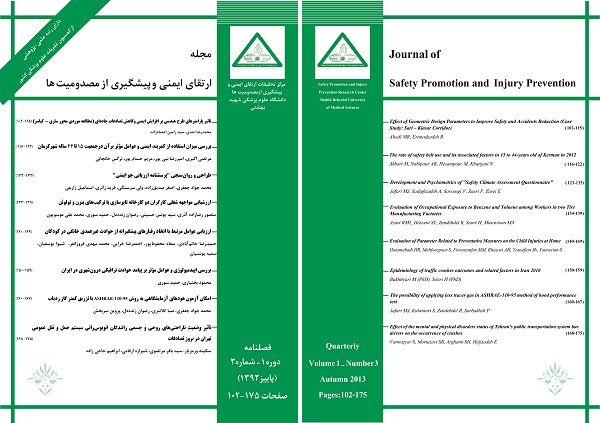...
ارتقای ایمنی و پیشگیری از مصدومیت ها,
دوره 1 شماره 3 (2013),
17 آذر 2013
,
صفحه 123-133
https://doi.org/10.22037/meipm.v1i3.5442
چکیده
Background and Aims: Eighty five percent of accidents can be attributed to unsafe acts. Eighty five to ninety eight percent of workplace injuries caused by unsafe acts are due to attitude, behavior and culture. Safety climate is a multi-dimensional structure that describes the attitude and the correct priority of the people towards the safety at work. To assess safety climate, a valid and reliable tool is needed. The aim of this study was developing a psychometric questionnaire to assess safety climate in Iran.
Materials and Methods: Using safety literature and other safety climate questionnaire, a 96-item questionnaire was provided. Face validity, content validity ratio and index, construct validity, internal consistency reliability and test-retest reliability were investigated on 550 industrial employees .After validity index survey 43 items questionnaire were obtained. Principal factors were extracted using exploratory factor analysis by Varimax rotation method. To check the reliability of the questionnaire, Cronbach's alpha coefficients and Pearson correlation coefficient was used.
Results: For the face validity, CVR(78.5%) and CVI(0.75) related to safety climate designed questionnaire to be acceptable, eleven factors were extracted that covered 58.85 percent of total variance. Cronbach's alpha for most factors more than 0.7 were calculated and Spearman coefficient showed significant correlation between test and retest results.
Conclusion: The Safety "Climate Assessment Questionnaire" which has been designed for 43 items and 11 factors has appropriate validity and reliability and can be used to assess the safety climate.
How to cite this article: Jafari MJ , Sadighzadeh A, Sarsangi V, Zaeri F, Zarei E . Development and Psychometrics of "Safety Climate Assessment Questionnaire". Irtiqa Imini Pishgiri Masdumiyat (Safety Promotion and Injury Prevention).2013; 1(3):123-133.
- Safety Climate
- Psychometric
- Validity
- Reliability
ارجاع به مقاله
- چکیده مشاهده شده: 1506 بار
- PDF (English) دانلود شده: 460 بار
